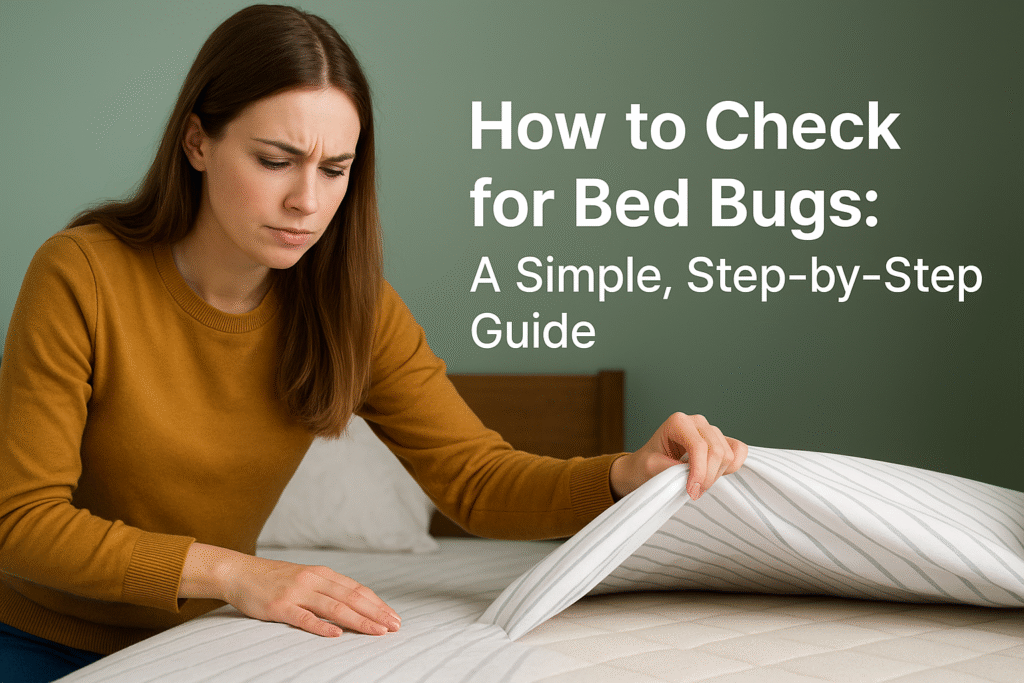
Nobody likes the idea of tiny insects hiding in their bed. The very thought can give you goosebumps. Yet, bed bugs are real and can appear anywhere—hotels, homes, or even your office chair. What makes them even more annoying is that they are hard to spot until their population grows. So checking on time and regularly is your best defense.
This blog will help you learn how to check for bed bugs step-by-step using simple language. You don’t need any professional equipment—just a flashlight, patience, and awareness.
What exactly are bed bugs?
Bed bugs are small, flat insects that survive by feeding on people while they sleep. They are about the size of watermelon seeds and are brownish-red in color. These insects cannot fly or jump, but they move fast and hide very well. They prefer dark, hidden areas such as mattress seams, furniture joints and even electrical outlets.
They often enter homes by hiding in luggage, used furniture or clothing. You can bring them in from hotels, public transportation or even a guest’s suitcase. Once they’re inside, they multiply rapidly, so it’s very important to act quickly.
Why should you check for bed bugs?
Even though they’re not known to spread disease, bed bugs do cause discomfort through bites. These bites often appear in a straight line or clusters and can cause itching, redness or swelling. For some people, the emotional stress of having bed bugs can be just as bad as the physical reaction.
By learning to check for them quickly, you can avoid a massive infestation and the high cost of professional pest control later.
When to Check Your Home
There’s no set time, but you should check:
If you’ve traveled recently
After hosting overnight guests
When buying or bringing in secondhand furniture
If you notice small bite marks or unusual spots on your sheets
Signs of a Bed Bug Problem
Before you begin a physical inspection, you should be aware of these common signs:
Itchy bite marks on your arms, legs, or back
Tiny spots of blood on your pillowcase or sheets
Black or brown spots that may be feces
A strange, musty smell near your bed or couch
Places to inspect first
Start with where you sleep. Bedbugs usually live near where people rest. Here are the main areas to pay attention to:
Mattresses: Look carefully at seams, corners, and under tags. Use a flashlight to look for bugs or their eggs.
Box springs: Remove the dust cover and check inside and any cracks or folds.
Bed frame and headboard: Check around joints, screw holes, and behind the headboard.
Couches and chairs: Check under cushions, along seams, and in hidden folds.
Nightstands and baseboards: Bedbugs sometimes hide inside drawers or along the edge where the floor meets the wall.
How to inspect
Strip your bed: Remove all sheets, pillowcases, and mattress covers. Wash them immediately in hot water.
Use a flashlight: Shine it into corners, seams, and any dark areas. These pests don’t like bright light and usually hide in small spaces.
Use a card or knife: A flattened card or butter knife can help you scrape along seams and edges to find hidden insects.
Look for clues: In addition to live insects, look for tiny white eggs, shed skins and dark stains, which could be feces or dried blood.
Be patient: This isn’t a 5-minute job. Move slowly and check carefully.
What bed bugs look like
Adult bed bugs are small – about 5mm – and flattened unless they have recently fed.
Eggs are small, about 1mm, white and usually found in hidden clusters.
Nymphs are tiny insects that are almost transparent and hard to spot.
Common mistakes to avoid
Some people mistake fleas, carpet beetles or even lint for bed bugs. Make sure you identify the insects correctly. Fleas jump; bed bugs do not. If you’re not sure, trap one with clear tape or in a small container and compare to online photos or take it to a pest control specialist.
Preventing future problems
Here’s how to reduce the risk of bringing bed bugs into the home:
Don’t buy used mattresses unless cleanliness is confirmed.
After traveling, inspect your luggage before bringing it home.
Use bed covers with zippers to deter these pests.
Keep your home clean and reduce clutter.
Vacuum regularly around your bed, couch and baseboards.
Using bed bug traps
You can place sticky traps or interceptors under the legs of your bed. These don’t solve the infestation, but they can help confirm whether bugs are present. They work by catching bugs that try to climb up or down on furniture.
When to call a professional
If you find more than a few bugs or signs in several places, it’s time to call a licensed pest control service. Home remedies won’t work for a large infestation. Professionals have tools and treatments that penetrate deep into furniture, walls and cracks.
Conclusion
Bed bugs can be stressful, but having information gives you power. Now that you know what to look for and how to search properly, you can take steps to protect your home. Make checking part of your routine – especially after traveling or having guests. Early detection means easier treatment.
Remember, bed bugs don’t mean you’re dirty or careless. They can appear in any home, clean or messy. But with regular checkups and awareness, you can keep them out and sleep easy at night.
